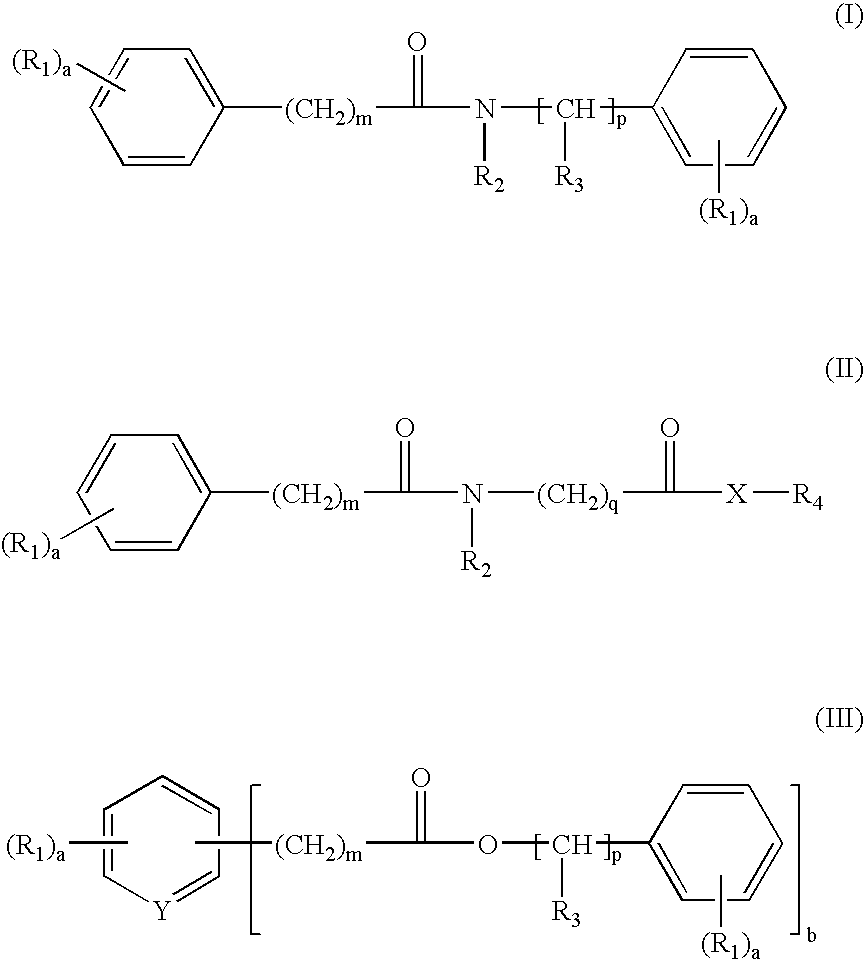Dibenzoylmethane sunscreens photostabilized with arylalkyl amide or ester compounds
a technology of dibenzoylmethane and arylalkyl amide, which is applied in the field of dibenzoylmethane derivatives, can solve the problems of unfavorable continuous protection, unfavorable cutaneous aging, and unfortunate tendency to decompose more or less rapidly
- Summary
- Abstract
- Description
- Claims
- Application Information
AI Technical Summary
Benefits of technology
Problems solved by technology
Method used
Image
Examples
synthesis examples
Example 1
Preparation of 1,3-dimethylbutyl(benzoylamino)acetate
[0196]
[0197] A mixture of hippuric acid (8 g, 0.0446 mol), of 4-methyl-2-pentanol (6.8 ml, 0.0536 mol) and of 98% sulfuric acid (0.41 ml, 0.00446 mol) in 100 ml of toluene is heated at 80° C. for 17 hours. A second addition of 4-methyl-2-pentanol (6.8 ml, 0.0536 mol) and of 98% sulfuric acid (0.41 ml, 0.00446 mol) is carried out and the reaction mixture is brought to reflux for 7 hours. The reaction mixture is evaporated to dryness under reduced pressure. The residue is taken up in ethyl acetate and washed twice with water. The isolated organic phase is dried over sodium sulfate. After filtering and evaporating the solvent, the yellow oil obtained is chromatographed on silica (eluent: heptane / EtOAc 80:20) to give 3 g (22% yield) of clean fractions of the compound of Example 1 in the form of a pale yellow oil.
example 2
Preparation of 2-ethylhexyl(benzoylamino)acetate
[0198]
[0199] A mixture of hippuric acid (6.25 g, 0.0349 mol), of 2-ethyl-1-hexanol (6 ml, 0.0384 mol) and of 98% sulfuric acid (0.18 ml, 0.00349 mol) in 20 ml of toluene is heated at reflux for 17 hours. The reaction mixture is evaporated to dryness under reduced pressure. The residue is taken up in ethyl acetate and washed twice with water. The isolated organic phase is dried over sodium sulfate. After filtering and evaporating the solvent, the yellow oil obtained is chromatographed on silica (eluent: CH2Cl2) to give 8.8 g (87% yield) of clean fractions of the compound of Example 2 in the form of a pale yellow oil.
example 3
Preparation of 2-ethylhexyl[(3-phenylpropanoyl)amino]acetate
[0200]
First stage: Preparation of 2-ethylhexyl aminoacetate
[0201] A mixture of glycine (4.36 g, 0.0582 mol), of 2-ethyl-1-hexanol (10 ml, 0.0639 mol) and of 98% sulfuric acid (0.311 ml, 0.00581 mol) in 20 ml of toluene is heated to reflux for 17 hours. 50 ml of toluene are added to the suspension obtained, 0.5 ml of concentrated sulfuric acid is added and the combined mixture is brought to reflux for 24 hours. The reaction mixture is evaporated to dryness under reduced pressure. The residue is chromatographed on silica (eluent: CH2Cl2 / MeOH 98:2) to give 7 g (87% yield) of clean fractions of 2-ethylhexyl aminoacetate in the form of an orangey oil which is used as is in the following stage.
Second stage: Preparation of the product of Example 3
[0202] 3.4 ml of oxalyl chloride (0.0384 mol) are added at 0° C. in 15 minutes to 3-phenylpropanoyl acid (4.81 g, 0.032 mol) dissolved in a mixture of 20 ml of anhydrous acetonitrile ...
PUM
| Property | Measurement | Unit |
|---|---|---|
| Fraction | aaaaa | aaaaa |
| Percent by mass | aaaaa | aaaaa |
| Percent by mass | aaaaa | aaaaa |
Abstract
Description
Claims
Application Information
 Login to View More
Login to View More - R&D
- Intellectual Property
- Life Sciences
- Materials
- Tech Scout
- Unparalleled Data Quality
- Higher Quality Content
- 60% Fewer Hallucinations
Browse by: Latest US Patents, China's latest patents, Technical Efficacy Thesaurus, Application Domain, Technology Topic, Popular Technical Reports.
© 2025 PatSnap. All rights reserved.Legal|Privacy policy|Modern Slavery Act Transparency Statement|Sitemap|About US| Contact US: help@patsnap.com



